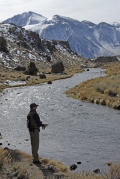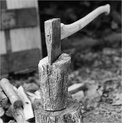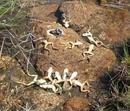M.A.D. Mountain-Pub Crawl
 Spring has Sprung!
Spring has Sprung!Host: Mammoth After Dark
Start Time: Thursday, April 30 at 11:30am
End Time: Thursday, April 30 at 11:30pm
Where: Mammoth Mountain and The Village at Mammoth
More details and RSVP...

by David T. Page
"Open to any page and you'll find a great story, along with details that will inspire travel—and more reading." —Westways



Death Valley's Secret Stash
(Men's Journal)
Really Old Masters
(NY Times)

The World's Most Traveled Man?
(Men's Journal)

Skiing CA's 14ers
(Eastside Magazine)

Wild Ice
(NY Times)

Rituals: The Last Run
(NY Times)
More...
 Spring has Sprung!
Spring has Sprung! Mike Mckenna lays
Mike Mckenna lays Christian Pondella
Christian Pondella Mark Douet/
Mark Douet/ Scientists count Devils Hole pupfish larvae at Ash Meadows National Wildlife Refuge. Monica Almeida/The New York Times.“I got nothing,” shouted Paul J. Barrett, a U.S. Fish and Wildlife Service biologist, during a recent pupfish count deep in Devil's Hole, Death Valley National Park, as reported in The New York Times.
Scientists count Devils Hole pupfish larvae at Ash Meadows National Wildlife Refuge. Monica Almeida/The New York Times.“I got nothing,” shouted Paul J. Barrett, a U.S. Fish and Wildlife Service biologist, during a recent pupfish count deep in Devil's Hole, Death Valley National Park, as reported in The New York Times.
It doesn't look good for the tiny fish that once stopped Vegas in its tracks.
Meanwhile, up in the Sierra, the alpine chipmunk heads for the sky.
 Not the first Yosemite stamp. But will it be the last?A new 42-cent first-class stamp featuring Albert Bierstadt’s 1864 oil painting “Valley of the Yosemite” debuted Thursday morning at the Yosemite Village Post Office. The last Yosemite stamp (2006) featured a sunrise photograph by Galen Rowell and sold at the bygone international letter rate of $.84. (LAT)
Not the first Yosemite stamp. But will it be the last?A new 42-cent first-class stamp featuring Albert Bierstadt’s 1864 oil painting “Valley of the Yosemite” debuted Thursday morning at the Yosemite Village Post Office. The last Yosemite stamp (2006) featured a sunrise photograph by Galen Rowell and sold at the bygone international letter rate of $.84. (LAT) Carcasses of Southern Yellow-legged Frogs in Sixty Lake Basin in Sierra Nevada, California. The frogs died of chytridiomycosis, an amphibian disease caused by a particularly virulent fungus. (Vance Vredenburg)"There's no question that we are in a mass extinction spasm right now," said David Wake, professor of integrative biology at UC Berkeley in a press release. "Amphibians have been around for about 250 million years. They made it through when the dinosaurs didn't. The fact that they're cutting out now should be a lesson for us."
Carcasses of Southern Yellow-legged Frogs in Sixty Lake Basin in Sierra Nevada, California. The frogs died of chytridiomycosis, an amphibian disease caused by a particularly virulent fungus. (Vance Vredenburg)"There's no question that we are in a mass extinction spasm right now," said David Wake, professor of integrative biology at UC Berkeley in a press release. "Amphibians have been around for about 250 million years. They made it through when the dinosaurs didn't. The fact that they're cutting out now should be a lesson for us."